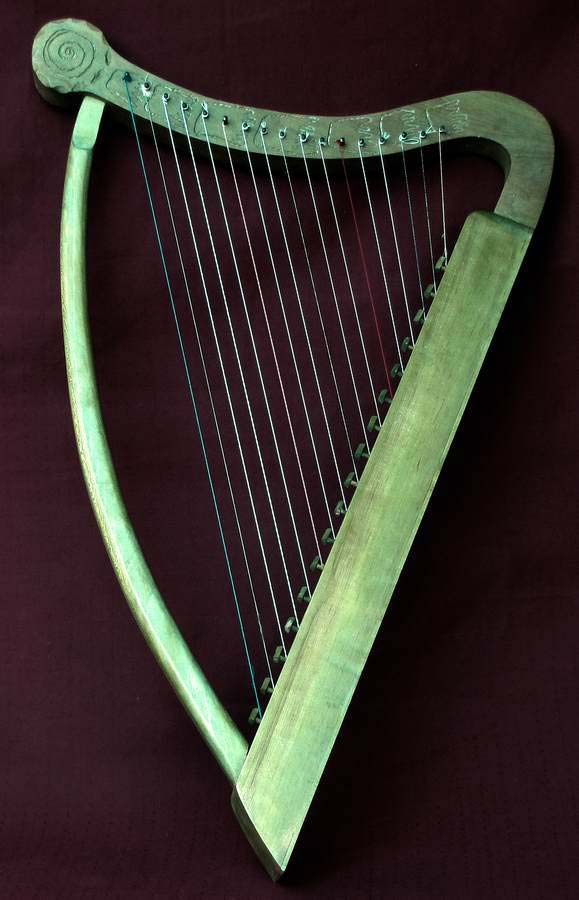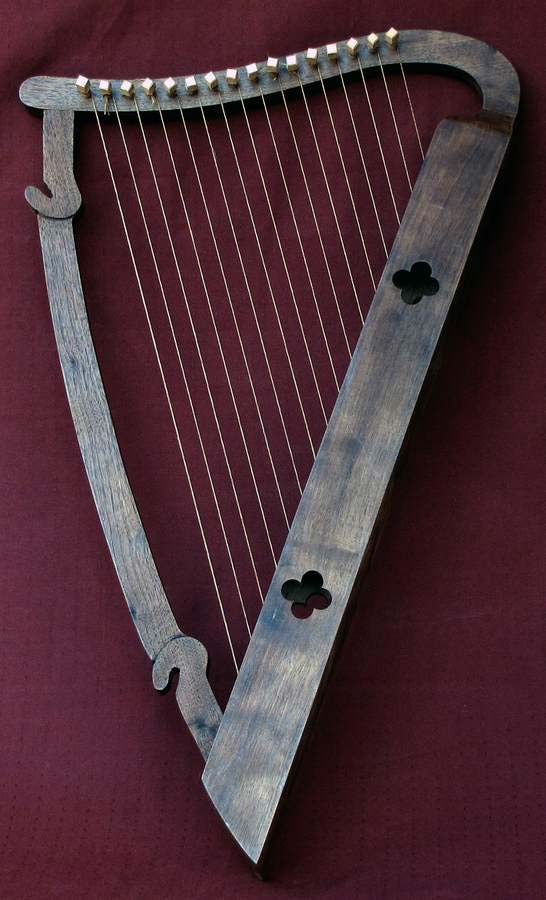Many feel the harp is the oldest stringed instrument known to man. Early open harps, resembling hunting or military bows with resonator chambers, have existed in human art almost as long as it has been drawn, painted or carved. Each culture has had it's own unique imprint on the harp family. In Europe, toward the end of the first millennium, the triangular harp began to appear. As early as the middle of the eighth century these harps were documented in manuscripts, and by the tenth century small frame harps were depicted in all media, from statuary to textile. This is the small harp from which today's folk lap harp was derived. Strung in everything from horsehair to wire, these harps took their place along side the Lyre and Gusli and Kantele as the instruments of the performing historian, the minstrel newsman, the storyteller, the epic poet and singer
We base our instruments on archaeological evidence, historical art and written documentation, but we do not replicate these instruments. Instead, we choose to take what we know from these sources and our own experience, mix in the imagination of the customer, occasionally add in a drop of technological magic, and create what a harp builder of this era would have created, a unique piece for his client. So drop us a message or give us a call. We promise, we won't charge to answer your questions.

Early Irish Straight Arm
The earliest depictions are
on Irish stonecarvings. These early triangular
frame harps would have usually somewhere between nine
and sixteen strings, and were light and small enough to
carry but large enough to have some acoustic
presence. The straight arm design had it's
drawbacks, but usually this design favored the middle
range. The ends of the arm were often designed
with zoomorphic or caricature heads or sometimes natural
motifs like thistles or flowers. This is a large
Irish bardic harp, sixteen strings, can be strung with
gut or nylon.
Early Curved Arm

Another
common term for this small and well developed harp is
Romanesque. Like the Gothic, it has nothing to
do with the Roman period, but the general construction
and visual cues are similar to Roman designs -
visually heavy, large and robust. But the harp
itself is very portable and easy to carry, and the
introduction of the curved arch evens out the string
tension between strings and lowers the overall tension
the instrument must bear. This allowed for
lighter soundboards that could project better, thus a
louder instrument. This example has 16 silk
strings and is fitted with bray pins. It is
ornamented with primitive Celtic astrological symbols.
Welsh Telyn Rawn

Wales was long known for it's
independence, it's strong will and
unique hospitality. So well
known of course that the English, not
wishing to be overshadowed by this
hospitality and spirit of cooperation,
often found themselves at odds with
the Welsh. During these times
the travelling Welsh bard was quite
busy, travelling and meeting secretly,
keeping high the friendly spirits of
the Welsh, inspiring thoughts of
friendly pranks and relatively
harmless hi jinx toward their English
brothers. This, the harp of the
shining black horsehair, was their
tool of choice (it was also well known
for beautiful music, but where's the
story in that?). The English,
being who they have always been, often
took measures to subdue these
cheerleaders, not enjoying the antics
nearly as much as the Welsh.
This instrument, unique among harps,
held such value for the Welsh that it
was often part of bride-price
negotiations, and the English Crowns
were so enthralled with the instrument
that they often offered high reward
for any used by these bards that could
be added to their collection.
This example has 16 horsehair strings,
is made of dark walnut, with wooden
tuning pegs. It is difficult to
keep in tune due to the nature of the
strings being hair, the most
environmentally unstable string
material. It can be fitted with
bray pins. It is a very, very
light harp, not loud but with an
unmistakable and utterly unique sound.